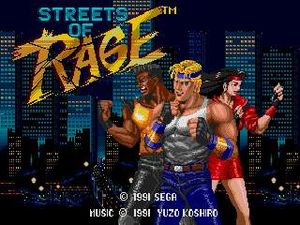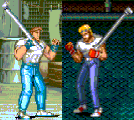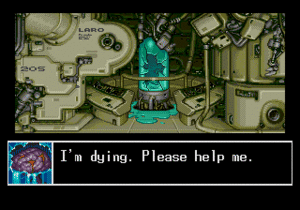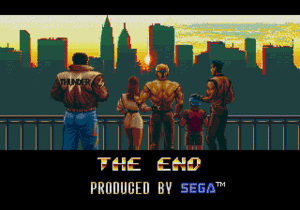Streets of Rage
Streets of Rage is a 1991 side-scrolling beat-em-up game released for the Sega Genesis. It received critical acclaim and was considered one of the best games in its genre. Its great gameplay, soundtrack, and storyline amassed a large legion of fans, and the game spawned two sequels and even a comic book.
Because of this, Sega saw fit to systematically anihillate the franchise and wipe any memory of it from the face of the Earth, leading many younger people to believe it never existed.
Gameplay[edit | edit source]
The storyline revolves around three police officers who are removed from the police force due to their fighting of "The Syndicate" (or mob, if you contain brain cells) and resort to vigilante justice. This is because "The Syndacate" controls the police force in the "City". Why the mob, er, syndicate wouldn't just kill off the main characters for being in the way is still questioned by those with far too much free time. The three police officers, and main characters of the game, are Axel Stone, Blaze Fielding, and Adam Hunter. Axel is the main character, and obligatory white hero, characterized by his blonde hair and blue jeans. Blaze is the typical attractive girl who does next to no damage, and is there primarily to garner the attention of male gamers. Adam is the character no one remembers, as he remained unplayable after the first game, and most people associate "Streets of Rage" with the sequel.
The goal of the heroes is to clean up the streets of the "City" and overthrow the evil "Syndicate". All in all, the storyline of the game has proven to be rather worthless in terms of enjoyment factor, and is now considered by all professionals in the field to be "An excuse to beat the hell out of a number of similar looking people for circa two hours."
Development[edit | edit source]
Streets of Rage was developed for basically a single purpose; To compete with Capcom's Final Fight, released for the far superior (But homosexually colored) Super Nintendo Entertainment System. The game was designed with success in mind. The developers knew what would make the game great, and that was to copy Final Fight as closely as possible without getting sued. Ironically enough, the main character, Axel, was not intentionally designed to look indestinguishable from Cody from Final Fight. The characters were designed by Ayane Koshiro (sister of legendary operatic composer Yuzo Koshiro)who was locked in her basement with a pad and pen and forced by her eccentric sibling to design characters for what he described as "The vessel for which shall contain my greatest masterpiece of work for which to grace mankind with my ultimate genius of sonic fortitude!"
Once the character designs and soundtrack were completed, the developers took ten minutes out of their tight production schedule to slap together something resembling a video game. Thus the legend of Streets of Rage had begun...\
Soundtrack[edit | edit source]
Arguably the most important factor in Streets of Rage's success was its soundtrack. To put it in understandable terms, the soundtrack to Streets of Rage was "Frikkin Awesome" (complete with New Jersey accent). Composed by the previously mentioned Yuzo Koshiro, the music in the game was one of the only actual good reasons to play it (This was later rectified in Streets of Rage 2, where they made a game to go along with the soundtrack). The soundtrack was an absolutely immacculately formulated ripoff of a number of 1990's dance hits. It has been praised by many for its originality.
Sequels[edit | edit source]
Because of the success of the original game, a second game was designed. There was extensive debate as to what this sequel to Streets of Rage should be called. The title "Streets of Rage 2" was eventually decided on. The developers, feeling emboldened by their previous success, decided to make the graphics look less like Lego pieces. This decision paid off, and Streets of Rage 2 ended up far surpassing the first game in sales and popularity. Streets of Rage 2 replaced Adam Hunter with a steroid filled, maniacal man in a flamboyant pro-wrestler outfit, and a small, twelve year old child wearing rollerblades. Streets of Rage 2 tends to be the only Streets of Rage game anyone remembers. It was by far the most popular of the trilogy. Cries of "GRAND UPPAAAHH!!!" could be heard through the halls of any given elementary school in the early 90's.
Streets of Rage 3 came out in 1996, and it is for the most part considered the bastard child of the series. Yuzo Koshiro was smoking crack and shooting up ketamine while composing the soundtrack, leading to music which sounded mostly like unintelligible noises coming out of an old IBM computer. Also the characters' costumes were altered to make them look like 1980's rejects. For some reason, the developers also decided to make the game impossible. On anything except for the easy difficulty, the game is unbeatable without massive cheating. Aside from those things, it is technically the best Streets of Rage game. Certain things were added to make the game more realistic, such as the ability to run, and cyborgs.
Streets of Rage 4[edit | edit source]
There is no such thing, and there never will be, get over it. Sega doesn't like you, and there's no way they'll ever make this game. It would go against their business model of making sure they never make games people want to play, especially Streets of Rage (and Shenmue 3). Sega knows people have wanted a new Streets of Rage for ten years, and there is no possible reason they wouldn't have made a fourth, aside from doing so just to make millions of fans terribly upset. It is widely speculated that Sega of Japan refused to make the game because they believed it might benefit Sega of America, which they've been trying to kill for a number of years.



